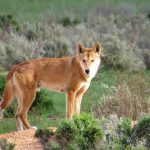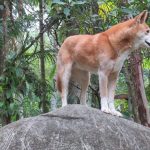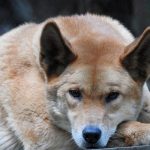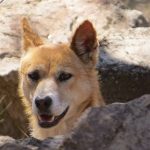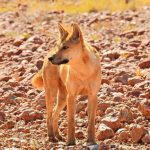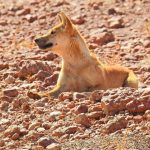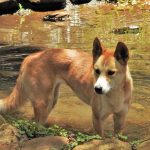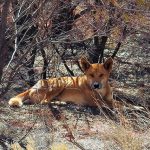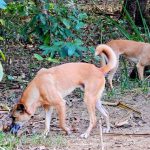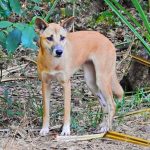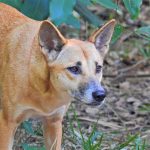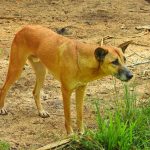DINGO
Australia’s Wild Canine Story
Deep within Australia’s tapestry of ecosystems, from sunburnt deserts to leafy forests, thrives an animal as enigmatic as the landscape itself—the dingo. Wanderers of the wild, dingoes carry with them a rich history intertwined with the story of both ancient peoples and modern conservation.
Origins & Arrival
Long before bustling cities or fence lines, around 4,000 years ago, humans brought dingoes to the Australian continent. These adaptable canids quickly established themselves across almost every habitat, evolving to become skilful survivors in the land of extremes.
Physical Features
Dingoes cut a lean, agile silhouette in the bush. Imagine:
- A pointed muzzle—shaping their keen sense of smell,
- Erect ears, twitching at every whisper in the wind,
- A bushy tail, often held low and relaxed.
Colouration ranges from sandy gold—blending with outback soils—to deeper reds, and occasionally black, brindle, or patchy patterns. This striking appearance not only aids in camouflage but also hints at genetic diversity.
Living on the Edge: Behaviour and Ecology
Survivors in Every Landscape
Dingoes are masters of adaptation:
- Nocturnal hunters, stalking the dark under a curtain of stars, yet sometimes active at dawn or dusk.
- Diet: They are opportunists, feeding on:
- Small mammals
- Birds
- Reptiles
- Insects
- Occasionally plant material and carrion
Sound of a dingo
At dusk, when the light thins and the air cools, a long, clear note carries across the open country. It is the dingo’s call—steady, unhurried, slipping through eucalypt shadows and over spinifex. This voice has threaded through Australia’s landscapes for thousands of years. Keeping it in our soundscape is as much about wisdom as it is about wildlife.
Picture dusk settling over open woodland: a low, hollow note rises, wavers, then glides away. That is a dingo’s call—clear, flute‑like, sometimes with a rising “yodel” quality. You might also hear a short bark that flips straight into a drawn‑out howl, known as a bark‑howl. When a whole family group answers, the chorus can seem larger than the group itself, a useful bluff to neighbours.
- Tone: smooth and carrying, not as deep as a wolf, less harsh than many domestic dogs
- Patterns: single long calls, repeated phrases, or layered group choruses
- Range: on calm nights, sound can travel several kilometres across open country
Why they howl
- Contact calls: to keep track of family members over distance
- Territory: to announce occupancy and avoid costly fights
- Rallying: to gather the group before moving to hunt
- Breeding season: more frequent in autumn when pairs are tightly bonded and pups are later guarded
- Alarm: a sharp bark may precede a howl if a threat is detected
Dingoes do bark, but they do so sparingly—often as an alarm. Hybrids with domestic dogs tend to bark more.
When and where you’re likely to hear them
- Time: mostly at dusk, night, and dawn; clearest on still, cool nights and often after rain
- Habitat: deserts, open woodlands, grasslands, and alpine valleys—places where sound carries well
Listening with care
If you’re lucky enough to hear or see dingoes:
- Observe from a distance; never feed them
- Secure food and rubbish in campgrounds
- Keep pets on a lead and close to you.
That long, haunting call is part of Australia’s natural soundscape. As top predators, dingoes help keep ecosystems in balance by influencing herbivores and smaller predators. Respecting their space allows both wildlife and people to share the landscape more safely.
Why dingoes matter
- Apex role: dingoes help balance ecosystems by influencing kangaroo and wallaby numbers and competing with invasive predators like foxes and feral cats.
- Ripple effects: where dingo populations are stable, vegetation can recover and small native animals often fare better.
- Cultural value: dingoes hold deep significance for many First Nations communities and are part of Australia’s natural heritage.
The main challenges
- Conflict with livestock: losses can be real for graziers, leading to lethal control.
- Hybridisation: interbreeding with domestic dogs can dilute dingo ancestry in some regions.
- Habitat fragmentation: roads, fencing, and development change how dingoes move and hunt.
- Habituation: feeding dingoes around townships and campgrounds leads to risky behaviour and often ends badly for the animals.
Practical ways to coexist
For travellers and campers
- Never feed dingoes; secure food, rubbish, and fish scraps.
- Observe from a distance; keep children close and pets on a lead.
- Store attractants (pet food, bait, carcasses) out of reach and out of camp.
For communities and landholders
- Use a toolbox of non‑lethal methods where feasible: targeted fencing, guardian animals, calving in secure paddocks, removing carcasses, and improved husbandry during vulnerable periods.
- Monitor and respond early: remote cameras, lights, and human presence can reduce risk before conflicts escalate.
- Support dingo‑smart education so residents and visitors know how to behave around wild dogs.
For policy and research
- Protect core populations in suitable habitats while supporting evidence‑based, place‑specific management on pastoral lands.
- Maintain genetic and ecological monitoring to understand ancestry, behaviour, and landscape effects.
- Back programs led by Indigenous rangers that blend cultural knowledge with science.
A listening ethic and a shared future
If you hear that evening howl, let it pass through the trees and fade. The dingo thrives when we keep our distance, manage food carefully, and choose solutions that reduce conflict without silencing the landscape.
The dingo’s voice is not just a sound; it is a sign that the country is working as it should. By managing stock responsibly, travelling thoughtfully, and supporting research and local knowledge, we can keep that clear, flute‑like call moving across the night—an old thread, still strong, stitching people and place to the living continent.

